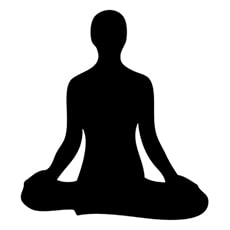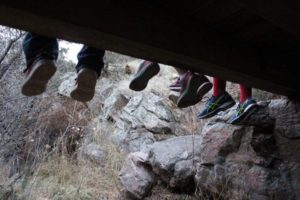
A body scan is a very specific type of guided meditation, although you can do it on your own as well. In this type of meditation, the instructor guides you to experience your entire body from head to toe, and to notice what each part feels like. This type of meditation can be very useful in becoming more present and anchored in our bodies, and in noticing places that might need attention, but it can also be very triggering for people whose bodies have been violated.
WHAT IT IS
Ron Siegel describes the body scan as a concentration practice because it dictates where we put our attention. During a non-guided meditation, we decide where to place our attention – the breath, sound, a mantra, etc. During a body scan we are instructed to place our attention on different areas of our body. Although similar, this is different than Edmund Jacobson’s progressive relaxation technique. Progressive relaxation involves tensing and relaxing muscles and is intended to promote relaxation. The body scan does not involve the tensing and relaxing of muscles, and has the intended purpose of increasing mindfulness and awareness of the body but not necessarily relaxation. If relaxation is a by-product of the body scan great, and if not, great.
The body scan can be particularly helpful when the mind is active and more prone to wandering than other times. It is also helpful for new meditators who need help developing the muscle of concentration. Siegal says that the body scan can help because the brain tends to stay more interested when we shift our attention to various parts of the body.
The body scan can also be helpful in noticing physical symptoms that might need attention, and in noticing our emotional reaction to physical symptoms. When we become more attuned to our bodies we notice shifts in sensations and we begin to notice which sensations normally shift and which ones might need medical attention. When we struggle with injury or pain, the body scan can help us notice our emotional response to the pain, and we can then learn how to relate to the pain more skillfully.
John Kabat-Zinn uses the body scan in his Mindfulness Based Stress Reduction (MBSR) program. The benefits, he says, are to help the nervous system rebalance itself by bringing awareness to the physical sensations of the body. According to the Mayo Clinic, this type of meditation can increase our sense of balance and peace, it can reduce stress, and help us have a more positive state of mind.
CHALLENGES FOR SURVIVORS
If reading the above description of the body scan did not make the hair on the back of your neck stand up at least a little I would be very surprised. Usually the idea of being more present in, and more aware of your body makes survivors anxious and want to run the other way. Why in the world would you want to be IN your body?
When your body has been violated, it usually involves pain. Sometimes excruciating pain. The smartest, most helpful thing you could have done during the abuse was to dissociate, to shut down, to leave your body in some way. Being abused is more than your body and mind can process. Your brain literally has no way to make sense of what is happening, and so it is forced to leave the experience floating around in your head without filing it properly because there is nowhere to file it. Your body does the same thing. There is no way for your body to process the things it experiences during the abuse, and so it is forced to deal with it by trying to pretend it is not happening by shutting down. It really is quite amazing how your body and mind can take you somewhere else or go into a foggy place so that you can somehow get up the next day and manage to function in the world as if nothing happened. It is a brilliant strategy.
There are a couple of problems with this brilliant strategy however. At some point the experience catches up with you. For some, it catches up right away, and for some it can take years. But it can’t stay hanging out in a black hole forever and at some point, you have nightmares, or body memories or other things that let you know it really happened and you must deal with it.
The other problem is that keeping the experience in a black hole takes its toll on you. It requires a lot of energy to keep pushing something away. It can also cause physical complications like headaches, lowered immunity, autoimmune diseases, heart problems, etc. Survivors often have trouble sleeping and struggle with intimate relationships. So, while the strategy of staying out of your body works temporarily, it does not work for the long run.
Knowing that staying out of your body does not work permanently, does not fix the issue of bristling at the thought of a body scan however. Going thru each part of your body at the slow pace of a meditation can be excruciating. Not literally excruciating, but it can seem like that. Your body has not historically been a friendly place to be, so focusing on your body inch by inch very slowly just does not have much appeal for many survivors. Especially staying focused for 30-60 minutes!
And yet, it has many benefits to offer, things that would be very helpful dealing with many of the problems survivors deal with.
Just like taking on anything new that is difficult, it can be very helpful to keep in mind the reasons why you want to do a body scan. And if WANT is too strong of a word, keep in mind the reasons you are willing to give it a shot. Keeping motivations for the things we are doing at the front of our mind is always a good idea.
Prepare yourself. In every body scan I have ever listened to, the instructor has always spoken in a very soft, slow voice. For many, just this style of speaking can be triggering. Having someone even talking about your body can be triggering. Having someone directing you where to place your attention on your body can be triggering.
For all of these reasons, consider recording your own body scan. It is not hard to find a written transcript or an outline of one. Find one that appeals to you, or just get the idea of what is involved in a typical body scan and write your own script. I would suggest keeping it shorter than a full body scan to begin with – maybe 10 minutes. If you don’t like the sound of your own voice, you could always enlist a friend or counselor to record it for you. But even then, you need to direct the recording. Tell them the volume and tone and pace you want them to have. This is your creation so take your time and get it right.
Make several short recordings focusing on specific areas rather than trying to do the whole body all at once. Start with the least triggering part of your body. For some that might be feet and legs, for some it might be hands and arms, for others it might be neck and shoulders. As you become more able to tolerate being in your body you can include parts of your body that are less comfortable and more triggering. But make sure to include those parts when you are ready. Those parts need healing just as much, if not more than the other parts.
If you can only tolerate being in your body for a minute or two, that’s where you start. There is no benefit to doing more than you can tolerate. The aim is to be kind to yourself, not to traumatize yourself even more. Remember that it is not your body’s fault that you were abused, and it deserves just as much compassion as any other part of you. Bringing your attention to your body is a way of offering it compassion. Our attention is one of the most loving things we have to offer to ourselves and others.
Maybe when you first begin, the safest place is your head. Great, start there. Notice what your eyes feel like behind your eyelids. Notice your forehead. Is there tension, wrinkling of your brow, softness? Notice where your tongue is in your mouth – is it resting at the bottom of your mouth or is it at the roof of your mouth. Remember you are not trying to change your experience, just notice.
With any practice of this type, if you are in therapy make sure to let your therapist know what you are doing and enlist his/her help if appropriate. If you are not in therapy, make sure a trusted friend knows that you are trying something new, so they can lend support if needed, and seek out a counselor if you need to.
For some ideas on how to adapt other mindfulness practices, follow the link for a journal that has lots of suggestions for customizing some popular mindfulness practices to make them more accessible for trauma survivors:
MINDFULNESS SKILLS FOR TRAUMA AND PTSD: Mindfulness Practices Adapted to Fit the Needs of Survivors: Kay, Jeni: 9798856277752: Amazon.com: Books









